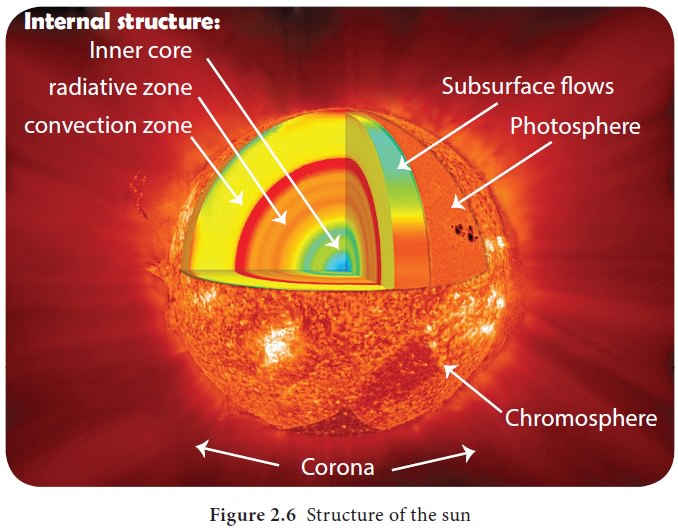Chapter: 11th Geography : Chapter 2 : The Solar system and the Earth
Structure of the Sun
The Sun is at the centre of our solar system. It is
a yellow dwarf star, with a hot ball of glowing gases. Its gravity holds the
solar system together and it keeps everything from the biggest planets to the
smallest particles of debris in its orbit. Electric currents in the Sun
generate a magnetic field that is carried out through the solar system by the
solar wind.
Structure
of the Sun
By mass, the Sun is made up of about 70.6% hydrogen
and 27.4% helium. The Sun's enormous mass is held together by gravitational
attraction, producing immense pressure and temperature at its core. There are
three main layers in the Sun's interior: the core, the radiative zone, and the
convective zone (Figure 2.6). The core is at the centre. It is the hottest
region, where the nuclear fusion reaction to give the sun power. Moving outward
next come the radiative (or radiation) zone. Its name is derived from the way
energy is carried outward through this layer, carried by photons as thermal
radiation. The third and final region of the solar interior is named the
convective (or convection) zone. It is also named after the dominant mode of
energy flow in this layer. The boundary between the Sun's interior and the
solar atmosphere is called the photosphere. It is what we see as the visible
‘surface’ of the Sun.

Did you know that the Sun has an atmosphere? The
lower region of the solar atmosphere is called the chromosphere. Its name is
derived from the Greek word chroma
(meaning colour), for it appears bright red when viewed during a solar eclipse.
A thin transition region, where temperature rises sharply, separates the
chromospheres from the vast corona above. The uppermost portion of the Sun's
atmosphere is called the corona, and is surprisingly much hotter than the Sun's
surface (photosphere) The upper corona gradually turns into the solar wind.
Solar wind is a flow of plasma that moves outward through our solar system into
interstellar space.
Therefore, the Sun has six regions: the core, the
radioactive zone, and the convective zone in the interior; the photosphere; the
chromospheres; and the corona. The temperature of the sun’s surface is about
5,500 to 6,000 degrees Celsius.
At the core, the temperature is about 15 million
degrees Celsius, which is sufficient to sustain thermonuclear fusion. This is a
process in which atoms combine to form larger atoms and in this process,
released, staggering amounts of energy. Specifically, in the Sun’s core, hydrogen
atoms fuse to make helium.
Size and Distance
The sun has a radius of 695,508 kilometres. It is
far more massive than earth and 3,32,946 Earths equal to the mass of the Sun.
The Sun’s volume would need 1.3 million Earths to fill it.
Venus is hotter than Mercury because
Venus has an atmosphere which is thicker
and made almost entirely of carbon dioxide.
Related Topics